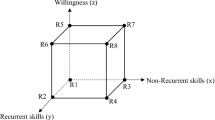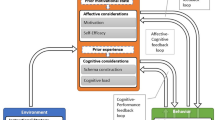Abstract
A 3-step strategy is proposed for cognitive/information processing task analysis which may lead to practical procedures for task analysis and instructional design. The three steps are: (1) concept hierarchy analysis, (2) analysis of example sets to teach relations among concepts, and (3) analysis of problem sets to build a progressively larger schema for the problem space. The strategy avoids extremely detailed information flow analysis performed in much descriptive research on human information processing. The research basis of the strategy is outlined by offering a descriptive model of human performance which identifies four dimensions: (1) Knowledge System, (2) Cognitive/Information Processing System, (3) Physiological System, and (4) Motivational/ Emotional System. The Knowledge Dimension is analyzed as consisting of problem-solving tasks, because of the basic cognitive process of perception. Problem-solving is structured by expectancies, which are in turn structured by schemata. Hence, the strategy proposed for task analysis focuses on identifying the structure of the schema underlying a problem space. Implications of the strategy for design of instruction to teach the schema are discussed. Contrasts are drawn with conventional (Gagné-style) methods. Examples from aviation training are presented.
Similar content being viewed by others
References
Allen, T. W., Rose, A. M. and Kramer, L. J. (1978). “An Information Processing Approach to Performance Assessment: III. An Elaboration and Refinement of an Information Processing Performance Battery.” American Institutes for Research, Technical Report No. 3.
Alluisi, E. A. (1967). “Methodology in the use of synthetic tasks to assess complex performance,” Human Factors 9 (4): 375–384.
Anderson, J. R. (1980). “Concepts, Propositions, and Schemata: What are the Cognitive Units?” Technical Report 80-2. Department of Psychology, Carnegie-Mellon University.
Bartlett, F. C. (1932). Remembering. Cambridge, England: Cambridge University Press.
Becker, W. C., Engelmann, S. and Thomas, D. R. (1975). Teaching 2: Cognitive Learning and Instruction. Chicago: Science Research Associates.
Bobrow, D. G. and Norman, D. A. (1975). “Some principles of memory schemata,” in D. G. Bobrow and A. M. Collins (Eds.), Representation and Understanding: Studies in Cognitive Science. New York: Academic Press.
Bockhold, Jr., G. and Roth, D. R. (1978). “Performance Measurement System for Training Simulators.” General Physics Corporation, Electric Power Research Institute, EPRI NP-783, Project 769, Interim Report.
Braune, R. J. (1982) “Towards an Internal Model in Pilot Training.” Unpublished Master's Thesis. Savoy, Illinois: University of Illinois at Urbana-Champaign.
Bromage, B. K. and Mayer, R. E. (1981). “Relationship between what is remembered and creative problem-solving performance in science learning,” Journal of Educational Psychology 73 (4): 451–461.
Chase, W. G. and Simon, H. A. (1973). “Perception in chess,” Cognitive Psychology 4: 55–81, 1973.
Chi, M. T. H., Glaser, R. and Rees, E. (1981). “Expertise in Problem Solving.” Learning Research and Development Center, University of Pittsburgh, Technical Report No. 5.
Chiles, W. D. (1967). “Assessment of complex operator performance,” Human Factors 9 (4): 325–327.
Clark, D. C. (1971). “Teaching concepts in the classroom: A set of teaching prescriptions derived from experimental research,” Journal of Educational Psychology 62 (3): 253–278.
Cooper, L. A. (1980). “Recent themes in visual information processing: A selected overview,” in R. S. Nickerson (Ed.), Attention and Performance VII. Hillsdale, NJ: Lawrence Erlbaum Associates.
De Groot, A. D. (1965). Thought and Choice in Chess. The Hague: Mouton.
De Groot, A. D. (1966). “Perception and memory versus thought: Some old ideas and recent findings,” in B. Kleinmuntz (Ed.) Problem Solving. New York: Wiley.
De Vries, Jr., P. B., Eschenbrenner, Jr., A. J. and Ruck, H. W. (1980). “Task analysis handbook.” AFHRL-TR-79–45 (II). Brooks AFB, TX: Manpower and Personnel Division, Air Force Human Resources Laboratory, July 1980.
Dick, W. and Carey, L. (1978). The Systematic Design of Instruction. Glenview, IL: Scott, Foresman and Company.
Elstein, A. S., Shulman, L. S. and Sprafka, S. A. (1978). Medical Problem Solving. Cambridge, MA. Harvard University Press.
Engelman, S. (1969). Conceptual Learning. North Sioux Falls, SD: Adapt Press, Inc.
Evans, R. W. (1982). “Computer-based instruction of expert problem solving procedures: Ensuring access to relevant knowledge structures,” in Conference Proceedings of ADCIS 1982. Bellingham, WA: Western Washington University Press, pp. 298–303.
Fitts, P. M. and Posner, M. I. (1967). Human Performance. Belmont, CA: Brooks/Cole Publishing Company.
Fleishman, E. A. (1967). “Performance assessment based on an empirically derived task taxonomy,” Human Factors 9 (4): 349–359.
Gagné, R. (1977). The Conditions of Learning (3rd edition). New York: Holt, Rinehart, and Winston.
Gallagher, J. P. (1979). “Cognitive/information processing psychology and instruction: Reviewing recent theory and practice,” Instructional Science 8: 393–414.
Gibbons, A. S. (1980). “Pre-development analysis in military training,” NSPI Journal Feb.: 34–42.
Hills, B. L. (1980). “Vision, visibility, and perception in driving,” Perception 9: 183–216.
Hochberg, J. and Brooks, V. (1978). “The perception of motion pictures,” in E. C. Carterette and M. P. Friedman (Eds.), Handbook of Perception. Vol. X. New York: Academic Press.
Jensen, R. S. (1982). “Pilot judgment: Training and evaluation,” Human Factors, 24 (1): 61–73.
Kant, E. (1781). Critique of Pure Reason (Kritik der wahren Vernunft), (1st ed. 1781, 2nd ed. 1787, translated by N. Kemp Smith). London: Macmillan, 1963.
Kelley, M. J., Wooldridge, L., Hennessy, R. T., Vreuls, D., Barnebey, S. F., Cotton, J. C. and Reed, J. C. (1979). “Air combat maneuvering performance measurement.” NAVTRAE-QUIPCEN IH-315/AFHRL-TR-79–3 Williams AFB, AZ: Flying Training Division, Air Force Human Resources Laboratory, September.
Kennedy, R. S., Carter, R. C. and Bittner, Jr., A. C. (1980). “A catalogue of performance evaluation tests for environmental research.” Proceedings of the Human Factors Society, 24th Annual Meeting, 1980.
Kintsch, W. and van Dijk, T. A.. “Toward a model of text comprehension and production,” Psychological Review 85: 363–394.
Kozminsky, E., Kintsch, W. and Bourne, Jr., L. E. (1981). “Decision making with texts: Information analysis and schema acquisition,” Journal of Experimental Psychology: General: 110 (3): 363–380.
Klein, G. (1977). “Phenomenological Approach To Training.” AFHRL-TR-77–42. Wright-Patterson AFB, OH: Advanced Systems Division, Air Force Human Resources Laboratory.
Köhler, W. (1947). Gestalt Psychology. New York: Liveright Publishing Corp.
Landa, L. (1974). Algorithmization in Learning and Instruction. Englewood Cliffs NJ: Educational Technology Publications.
Loftus, G. R. and Mackworth, N. H. (1978). “Cognitive determinants of fixation location during picture viewing,” Journal of Experimental Psychology: Human Perception and Performance 4 (4): 565–572.
Low, W. C. (1980). “Changes in instructional development: The aftermath of an information processing takeover in psychology,” Journal of Instructional Development 4 (2): 10–18.
Mager, R. F. (1975). Preparing Instructional Objectives. Palo Alto, CA: Fearon Publishers.
Merrill, M. D. and Tennyson, R. D. (1977). Teaching Concepts: An Instructional Design Guide. Englewood Cliffs, NJ: Educational Technology Publications.
Miller, R. M., Swink, J. R. and McKenzie, Jr., J. F. (1978). “Instructional system development (ISD) In air force flying training.” AFHRL-TR-78–59. Williams AFB, AZ.: Flying Training Division, Air Force Human Resources Laboratory, December, 1978.
Minsky, M. A. (1975). “A framework for representing knowledge,” in P. H. Winston (Ed.), The Psychology of Computer Vision. New York: McGraw-Hill.
Morawetz, T. (1978). Wittgenstein and Knowledge — The Importance of On Certainty. Amherst, MA: University of Massachusetts Press.
Mourant, R. R. and Rockwell, T. H. (1972). “Strategies of visual search by novice and experienced drivers,” Human Factors 14 (4): 325–335.
Nelson, K. (1977). “Cognitive development and the acquisition of concepts,” in R. C. Anderson, R. J. Spiro, and W. E. Montague (Eds.), Schooling and the Acquisition of Knowledge. Hillsdale, NJ: Lawrence Erlbaum Associates.
Phillips, Jr., J. (1975). The Origins of Intellect — Piaget's Theory. San Francisco: W. H. Freeman and Company.
Rose, A. M. (1974). “Human information processing: An assessment and research battery.” Human Performance Center Technical Report No. 46, Ann Arbor, Michigan.
Rumelhart, D. E. (1975). “Notes on a schema for stories,” in D. G. Bobrow, and A. M. Collins (Eds.), Representation and Understanding: Studies in Cognitive Science. New York: Academic Press.
Rumelhart, D. E. and Ortony, A. (1977). “The representation of knowledge in memory,” in R. C. Anderson, R. J. Spiro, and W. E. Montague (Eds.), Schooling and the Acquisition of Knowledge. Hillsdale, NJ: Lawrence Erlbaum Associates.
Rumelhart, D. E. and Norman, D. A. (1981). “Analogical processes in learning,” in J. R. Anderson (Ed.), Cognitive Skills and Their Acquisition, Hillsdale, NJ: Lawrence Erlbaum Associates.
Schank, R. C., Lebowitz, M. and Birnbaum, L. A. (1978). “Integrated Partial Parsing.” Research Report No. 143, Yale Artificial Intelligence Project.
Sills, D. L., Wolf, C. P. and Shelanski, V. B. (1981). The Accident at Three Mile Island: The Human Dimension. Boulder, Co: Westview.
Simon, H. A. and Barenfeld, M. (1969). “Information-processing analysis of perceptual processes in problem solving,” Psychological Review 76 (5): 473–483.
Smith, N. K. (Translator) (1934). Immanuel Kant's Critique of Pure Reason (1st Edition). London: Macmillan and Co., Limited.
Spiro, R. J. (1980). “Schema Theory and Reading Comprehension: New Directions.” Technical Report No. 191. Center for the Study of Reading, University of Illinois.
Stoffer, G. R. (1981). “Performance measurement and the navy's Tactical Aircrew Combat Training System (TACTS),” Proceedings of the Symposium on Aviation Psychology, The Aviation Psychology Laboratory, The Ohio State University, Columbus, Ohio.
Tennyson, R. D. and Ok-Choon, Park (1980). “The teaching of concepts: A review of instructional design research literature,” Review of Educational Research 50 (1): 55–70.
Thorndyke, P. W. (1981). “Schema theory as a guide for educational research: White Knight Or White Elephant?” Invited Address presented at the American Educational Research Association annual meeting, Los Angeles, April 1981.
Tiemann, P. W. and Markle, S. M. (1978). Analyzing Instructional Content: A Guide to Instruction and Evaluation. Champaign, IL: Stipes Publishing Company.
Vernon, M. D. (1955). “The functions of schemata in perceiving,” Psychological Review 62 (3): 180–192.
Wickens, C. D. (1982). Engineering Psychology and Human Performance. Columbus, OH: Charles Merrill.
Wiener, E. L. and Curry, R. E. (1981). “Flight Deck Automation: Promises and Problems.” NASA Technical Memorandum 81206.
Young, A. W. and Deregowski, J. B. (1981). “Learning to see the impossible,’ Perception 10: 91–105.
Author information
Authors and Affiliations
Rights and permissions
About this article
Cite this article
Braune, R., Foshay, W.R. Towards a practical model of cognitive/information processing task analysis and schema acquisition for complex problem-solving situations. Instr Sci 12, 121–145 (1983). https://doi.org/10.1007/BF00122453
Issue Date:
DOI: https://doi.org/10.1007/BF00122453




